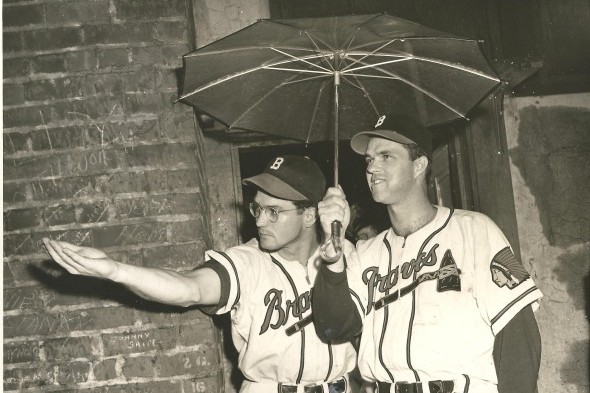
By David Eskenazi and Steve Rudman
Judging from the images on numerous of his Doo-Wop era baseball cards, the bespectacled Clifford Clark Torgeson (1924-90), the second “Earl of Snohomish,” easily could have passed for a mechanical engineer, a Mr. Wizard lab assistant, or perhaps even Mr. Peabodys pet boy, the geeky Sherman of cartoon fame.
His baseball-card countenance also shows that Torgy, as all referred to him, was close to a dead ringer for long-ago actor Quinn K. Redeker, who played a milquetoast inventor in the 1962 goofball epic, The Three Stooges Meet Hercules. Redekers movie creation, a time machine, cobbled together in the basement of a malt shop, enabled Larry, Moe and Curly to travel to ancient Ithaca and wreak comic chaos on classical Greeks.
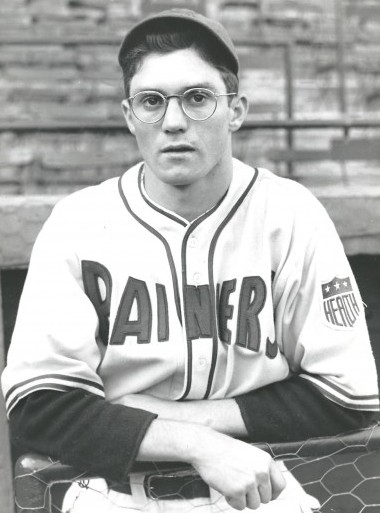
But this is exactly where looks meets deceiving.
While Torgy looked like the kind of guy who might have written code 24/7 (had computers existed in his day), he in fact carved a reputation as one of the great baseball brawlers of his era.
A 6-foot-3, 180-pound first baseman whom former Snohomish County Executive Willis Tucker described as so big that a golf club “looked like a licorice stick in his hand, Torgy engaged in an estimated (by Nash and Zullos Baseball Hall of Shame) 50 fights, fracases and melees during a 15-year major league career that included stints with the Boston Braves (1947-52), Philadelphia Phillies (1953-55), Detroit Tigers (1955-57), Chicago White Sox (1957-60) and New York Yankees (1961).
Torgys most famous (or infamous) donnybrook occurred July 1, 1952, when he got into it with New York Giants catcher Sal Yvars, a Little Italy-born son of a Spanish gravedigger and Italian laundress, and supposedly one of Torgys better baseball friends.
The back story: Yvars liked to set up close to the plate, too close, as far as Torgy was concerned. Torgy warned Yvars to back off several times, but Yvars refused. Irked at getting crowded, Torgy eventually took to flinging his bat backwards after hitting the ball, hoping to lay some bruises on Yvars. After Torgy nicked Yvars a few times, Yvars told Torgy that the next time he did it he would break Torgys bat.
The matter came to a head during an at-bat in the first inning July 1 in Boston after Torgys back swing caught Yvars on his shin guard. After the two engaged in an exchange of pleasantries, Torgy singled. He stood roosting on first when Yvars, staring defiantly, picked up Torgys bat and whacked it on home plate until he split the handle.
Torgy stewed until the bottom of the second, at which point he took off his cap, removed his glasses, trotted out of the Boston dugout and bolted across the diamond. When Torgy reached the New York bench, Yvars, his back turned, was strapping on his catching gear. Reaching Yvars, Torgy wheeled him around and socked him in the face, knocking him down. Torgy then gave Yvars a thorough pummeling.
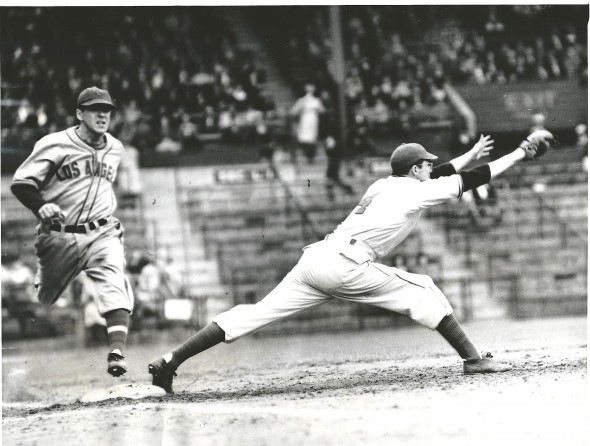
The Giants took Yvars to the hospital to receive stitches for a deep gash over his right eyebrow, and National League president Warren Giles fined Torgy $100, calling his attack unsportsmanlike and repugnant. Giles also fined Yvars $25.
Breaking a guys bat is like slapping him in the face. I dont have to take that insult, said Torgy, who brawled with Yvars again July 18, 1954 after both players changed teams.
Torgys first notable big league skirmish occurred during a 1948 exhibition game between the Red Sox and Braves. Torgys opponent was a player he also admired, Billy Hitchcock. Torgy was playing first base when Hitchcock got aboard and began taking substantial leads. On one pickoff attempt, the Braves pitcher threw high, and Hitchcock grabbed Torgesons leg so he couldnt jump and retrieve the overthrow.
For that, Torgy cleaned Hitchcocks clock, an action for which he received a $100 fine from Commissioner Happy Chandler. Torgeson admitted to Chandler that he started the fight after Hitchcock provoked him, but also commended Hitchcock for grabbing his leg.
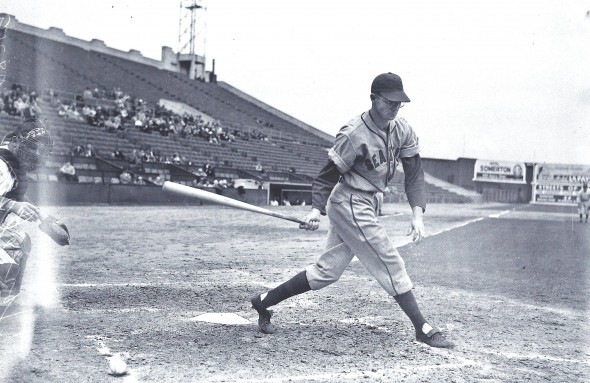
Id have done the same thing if I had been in Hitchcocks place, Torgy told Chandler.
A year later, in 1949, Torgy traded blows with teammate Jim Russell while the Braves were in Chicago. In that clubhouse altercation, Torgy suffered a thumb sprain while Russell emerged with two black eyes.
Both are fine fellows, Boston manager Billy Southworth told The Chicago Tribune. But each is hot-headed. It was just one of those sudden flare-ups and no significance should be attached to it. Jim and Earl shook hands, and the best feeling prevails between them at the present time.
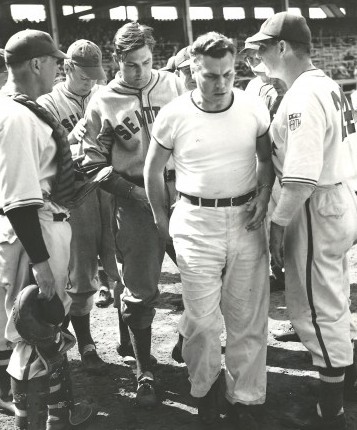
Two years later, in 1950, after pitcher Cliff Chambers of the Pirates drilled Torgy in the ribs following several brush-back throws, Torgy charged the mound, starting a multi-player melee.
Torgy is actually a very humorous fellow, and enjoys a practical joke, Boston teammate Roy Hartsfield said. But not after the game starts. Then hes fiercely competitive. Southworth seconded Hartsfield, saying, Hes tough as nails between the lines.
Hartsfield provided one illustration of that competitiveness for a Boston sports writer, saying, You should watch all the little things Torgy does in the batters box to throw the pitcher out of his rhythm. Hell step in and step out of the box. Hell dig in and pretend he has something in his eye. When the pitcher begins his windup, hell ask for time.
It didnt even take an on-field incident to raise Torgys ire. A few months before Torgy made his major league debut, in December 1946, two men accosted Torgy and his wife, the former Norma Syverson, on a Bellingham, WA., street. Torgy took out both for using foul language in front of his brand-new wife. A Bellingham judge fined Torgy $25, but the fine was tossed out on appeal by another judge, who noted, I would have done the same thing.
Torgy was in Bellingham to play for the towns entry in the new Pacific Coast Professional Basketball League (see Wayback Machine: The Seattle Athletics). The team, which included former Washington State star Gale Bishop and UW letterman Al Akins, had been dubbed the Fircrests, but local sports writers usually called them the Bells (for many years Bellingham featured a popular minor league baseball team by that name).
Torgy didnt see much action in the PCPBL after signing a one-year contract because the Boston Braves, who had purchased him from the Seattle Rainiers a few weeks earlier, objected stiffly to Torgys extracurricular basketball activities, fearing injury.
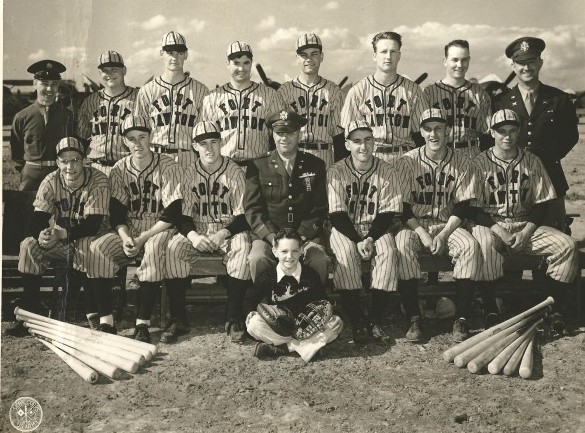
The situation had local precedent. In the winter of 1938-39, shortly after the Rainiers sold star pitcher Fred Hutchinson to the Detroit Tigers (see Wayback Machine: A Man And An Award) Hutchinson signed to play basketball with an independent professional team organized by Dr. Lew Richards, the Rainiers’ trainer who succeeded the legendary Ad Schact and preceded Freddie Frederico. The Tigers quickly educated Hutchinson about the folly of playing pro basketball.
Similarly, the Braves put so much heat on Torgy that he finally caved, which might be the only time in his 66 years that Torgy backed off from a confrontation.
Born Clifford Earl Torgeson in Snohomish on New Years Day, 1924, the same day George Wilson led the University of Washington football team in a Rose Bowl match-up with future movie cowboy Johnny Mack Brown and Alabama, Torgy was the second son of Melvin Carl Torgeson and the former Kornelia Gray, who divorced early in his childhood.
As Torgy grew up and began playing baseball, he came to idolize the first Earl of Snohomish, Earl Averill (1902-83), then in his Hall of Fame heyday with the Cleveland Indians {see Wayback Machine: Earl (And Pearl) of Snohomish}. According to the Society for American Baseball Research, Torgy became so infatuated with Averill that, when Averill returned to Snohomish after each baseball season, Torgy would follow him around town, and even watch him get a haircut.
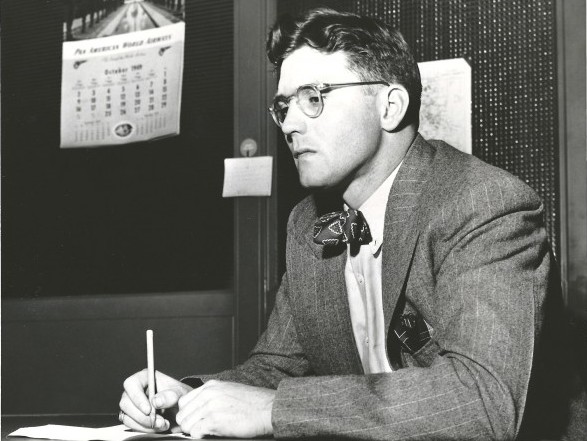
Like Earl I, Torgy developed into a phenom, so much so that when he turned out for high school football, the Snohomish town council ruled that the head coach could not keep Torgy on the team since an injury risked his hugely promising baseball career. After Torgy played in just two varsity games, a Snohomish sports writer joked that Torgy was the only ballplayer ever required by city ordinance to be a ballplayer.
Earl was an all-around athlete at Snohomish High School and I had somebody watching him for several years, Torchy Torrance, for many years the executive vice-president of the Seattle Rainiers, wrote in his 1988 autobiography Torchy! (see Wayback Machine: Roscoe ‘Torchy’ Torrance).
When Earl graduated, he came to me and said he didnt want a bonus to sign, he just wanted to prove himself as a ballplayer. I had been waiting to give him a chance for some time, so I sent him over to Wenatchee (Western International League), where Earl Jenner was the manager (actually, he worked in the front office).
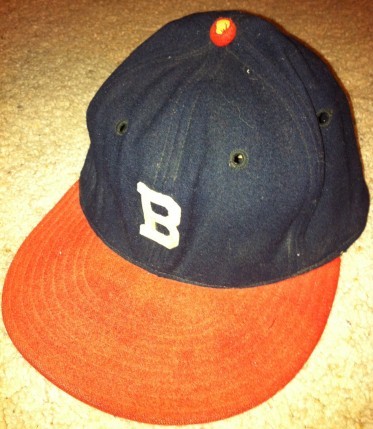
“The younger Earl wore big, horn-rimmed glasses at a time when nobody in baseball wore specs. Jenner called me and said, Why did you send that kid over here? He wears glasses! But all he did was hit .322 and win the pennant for Wenatchee.
En route to their third consecutive Pacific Coast League pennant, the Rainiers brought Torgy back to Seattle for the end of the 1941 season he went 4-for-10 in 10 games — and it was then that Torgy experienced his greatest baseball thrill. This is how Torgy described it to Baseball Digest in 1978:
The player I idolized ever since I was a kid was Earl Averill. We were both born and raised in Snohomish, and when I was a kid Earl was having all those great years with Cleveland. Anyhow, Earl finished his major league career in 1941 and signed with the Seattle Rainiers that year. It was also the year I broke into organized baseball, signing with the Rainiers.
Then it happened. I came out and looked at the lineup card in the dugout and it had Averill hitting third and playing center and me hitting fourth and playing first base. Here I was, only 17 years old, getting into the same lineup with the fellow whom I had idolized for years.
I had some great moments as a player and Ill cherish them all my life, but none could compare with that day when I played on the same team with Earl Averill.
Eighteen-year-old Torgy tore up the Rainers spring training camp in 1942 and started the regular season at Class B Spokane (Western International League). After hitting .429 during the opening week, the Rainiers summoned and Torgy hit .312 and averaged more than a hit a game, collecting 163 in 147 contests. He also stole 32 bases. The Rainiers thought so highly of Torgy that they made him the teams regular first baseman, replacing Les Scarsella, eventually sold to Oakland.
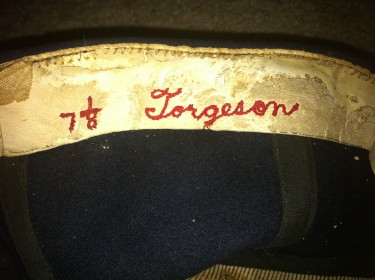
Torgy entered military service with the Army Jan. 15, 1943 and, after a stint at Fort Lawton, where he played on a service team, shipped out to Europe with the 70th Infantry Division. In February, 1945, the Rainiers received word that Torgy had been wounded in action which, according to Torrance, technically wasn’t the case.
Hed been picked up as dead with other members of his artillery unit, but one of the graves registration people noticed some movement and Earl was revived without lasting damage, Torrance wrote.
As World War II ended and dozens of ball players returning home from the service, Torrance began receiving inquiries from major league teams interested in acquiring Torgy, the New York Yankees and Boston Braves chief among them.
I was anxious to sell Torgeson to get some good ball players to help our club. Earl had indicated to me that he was interested in becoming a Yankee, Torrance wrote.
Torrance told Yankees boss Larry McPhail that he wanted $100,000 for Torgeson, but McPhail told Torrance that he was nuts: No player with just one year of PCL experience was worth that. So Torrance contacted Braves GM John Quinn and they agreed (Jan. 5, 1946) on a sale/trade in which the Braves received Torgy in exchange for $50,000 and five players whose combined contract value equaled another $50,000. The transaction also called for Torrance to play for the Rainiers in 1946 until he worked himself in baseball shape. Then he would report to Boston.
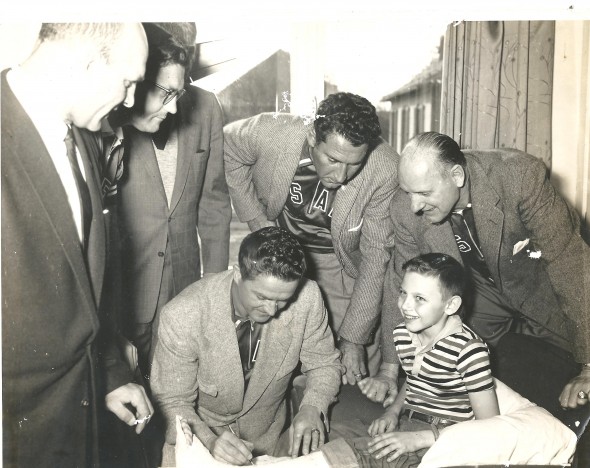
Torgys move to the majors stalled when he suffered a severe shoulder dislocation during game against San Diego, but on Aug. 31 the sale/trade became official. The Rainiers received the $50,000, but four players instead of five Lou Tost, Bill Ramsey, Hugh Poland and Tony York.
Torgy made his major league debut on the same day April 15, 1947 and in the same Ebbets Field game that Brooklyns Jackie Robinson broke the color barrier.
Robinson went 1-for-3 and scored what proved to be the winning run, in large part because of a Torgy muff at first. In the bottom of the seventh, Robinson bunted toward first and raced down the line. Torgy fielded the ball, but threw hurriedly, the ball grazing Robinsons arm and deflecting into right field. Robinson officially received credit for a sacrifice and Torgy for his first career error. Robinson scored the game-winning run on a double.
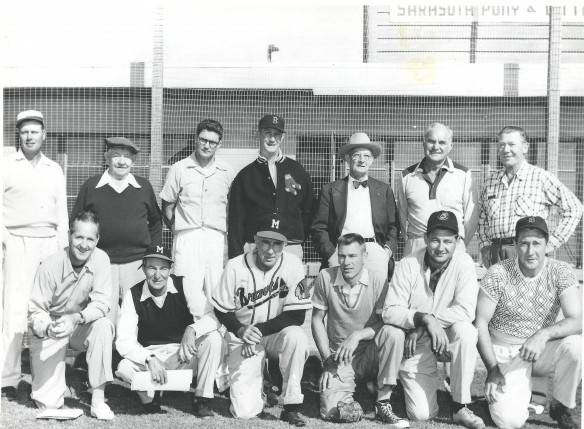
Torgy generally impressed as a rookie, hitting .281 with 16 home runs. But the remainder of his career failed to measure up to grand expectations predicted by some of his early supporters, especially Torrance. Certainly, the Second Earl of Snohomish hit nothing like the original, ending his career with a .265 batting average, 1,318 hits, 149 home runs, 749 RBIs and a nice .802 OPS. But Earl II did have his moments.
On May 13, 1947, Torgy drove in five runs with a home run, two doubles and a single in five at-bats, giving Boston and Warren Spahn a 7-4 win over Chicago.
Torgy collected the first walk-off hit of his career June 28, 1947 with a chalk-line double to right in the ninth with two outs that gave the Braves a 6-5 win over the Dodgers.
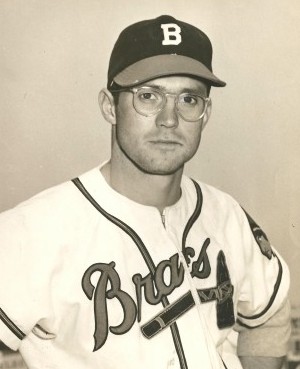
Torgy put together a career-high 22-game hitting streak from July 8-30, 1950, during which he hit .351 (33-for-94) with six home runs.
He also produced four hits in a game eight times, and drove in seven runs in a two-inning span June 30, 1951, when the Braves shellacked the New York Giants 19-7. Torgys seven RBIs that afternoon included a grand slam off Sal (The Barber) Maglie.
Three months after victimizing Maglie, Sept. 25, 1951, Torgy drove in six runs in the second game of a doubleheader against the Dodgers, a 14-2 Boston victory.
On Aug. 8, 1957, Torgeson whacked two home runs and drove in five as the White Sox beat the Kansas City Athletics 7-4.
One of Torgys more unusual games occurred May 30, 1947 against Brooklyn, when he played nine innings at first base without recording a single putout, which matched a National League record for idleness accomplished previously only by Rip Collins and Dolf Camilli, both in 1937 (Torgy had one chance at a putout, but missed a popup).
Torgy performed for three World Series teams, the 1948 Braves (lost to Cleveland), 1959 White Sox (lost to the Dodgers) and the 1961 Yankees (defeated Cincinnati), during his last season in the majors. Torgy never came close to winning a batting title, but in the 1948 World Series he led all hitters with a .389 mark (7-for-18 with three doubles).
Torgy injured his left shoulder trying to break up a double play started by Robinson in mid-May 1949 and was sidelined for the remainder of the season after playing just 25 games.
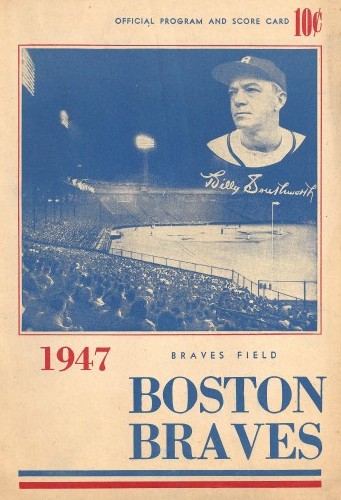
But he returned in 1950 with his best season, hitting a career-high .290 with 23 home runs and 87 RBIs. His 120 runs led the National League.
While his 23 homers dont sound like much, in 1950 only two National League regulars at first base outpaced him, Gil Hodges with 32 and Ted Kluszewski with 25. Torgy also led NL first basemen with 20 stolen bases.
Torgy had career-highs of 24 home runs and 92 RBIs in 1951, but after he dropped to .230 in 1952, the Braves sent him to the Phillies in a four-team swap, and he never had another big season.
Torgys most famous baseball moment occurred July 17, 1955, during his last year with the Detroit Tigers, in a game against Casey Stengels Yankees.
With the score tied 5-5 in the bottom of the 10th, Torgy drew a walk off New York pitcher Eddie Lopat to lead off the inning. Stengel immediately went to his pen, importing Bob Turley.
According to The New York Times, That move took an evil turn when Ray Boone (Bret Boone’s grandfather) singled to left, Torgeson going to third and Boone to second on the throw-in.
“Here Turley and the Yanks made a stout stand. Bob Maxwell grounded to Gil McDougal, Torgeson holding third. Red Wilson grounded to Andy Carey for the second out and again Torgy held third.
That left only Harry Malmberg, a .234 hitter, to be disposed of. But he never got that far. With one strike on Malmberg, Torgeson, taking advantage of Turleys double-pumping motion as he went into his delivery, lit out for the plate. He got there a fraction ahead of the pitch and the ball game was over.
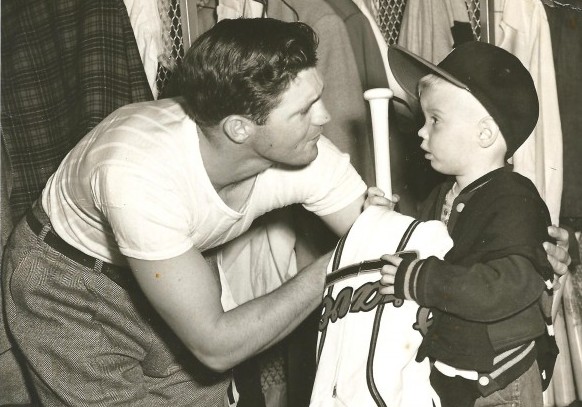
Asked about his pure steal of home years later, Torgy told Baseball Digest, A lot of people dont remember that I had an excellent stolen-base percentage. They didnt catch me very often. But that steal off Turley was special.
“The Tigers and Yankees always enjoyed a great rivalry and this was an important game. And it was the last time Turley ever pitched with a windup. Some writer walked up to Casey Stengel after the game and said he wanted to talk to Turley. Casey told him, Hes still on the mound winding up.”
Torgesons audacious home invasion became Torgys No. 2 favorite major league moment. He detailed his favorite, also to Baseball Digest:
The first was in 1948 with the Braves when we won the National League pennant. We were kind of a shaky ball club all year long. We never were able to build up a sizeable lead, and every time we looked over our shoulders the Brooklyn Dodgers were right behind us.
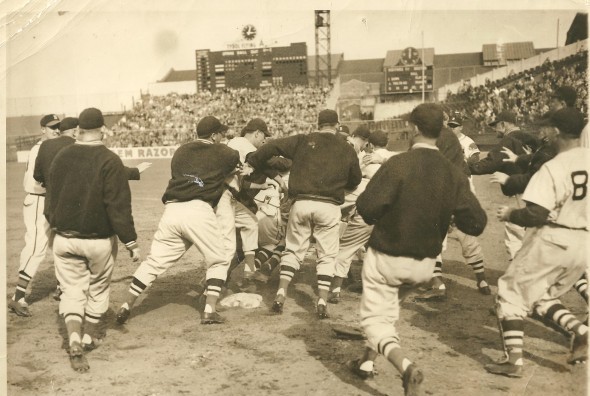
It was late in September, the Dodgers were gaining on us, and we had this big game to play at Ebbets Field. The Dodgers were always tough to beat at home and we knew theyd be doubly tough with the National League pennant race being as close as it was.
We were at-bat in the top of the eighth and the score was tied. We put two runners on base and I was up. As I said, it was an important game and both teams had used just about everybody on their benches.
“The Dodgers brought in a left-hander, Joe Hatten, to pitch to me, a left-handed hitter. Id been having a pretty good year, but our manager, Billy Southworth, who liked to platoon, was looking around for a righty to bat against Hatten.
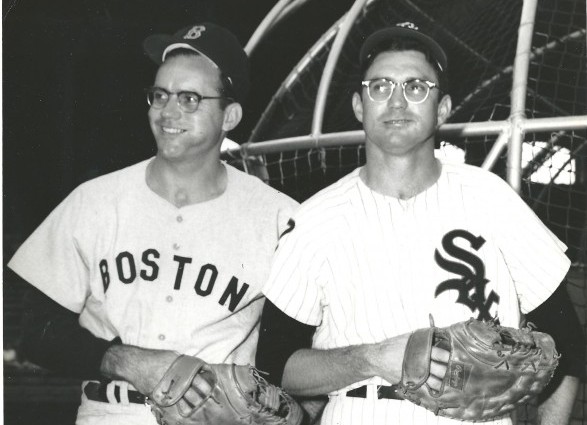
But we had no right-handed hitters left. Southworth had used them all. I remember he kept looking around for somebody to send up. Finally, I walked to the plate and hit a double off the fence in left center to score both runners.
“That hit not only won the game, it turned everything around for us. We gained some breathing room and a lot of confidence. I think we also became a solid ball club that day. We clinched the pennant shortly afterward, but to this day most of the players who were on that team will tell you we really won the pennant that afternoon in Brooklyn.
The base hit off Hatten had added significance for me. The prevous year I guess it was about June or July I was hitting about .320 was among the league leaders in just about every category home runs, runs batted in, stolen bases, everything. I had just finished a 17-game hitting streak and we went into Pittsburgh and I was really sitting on top of the world.
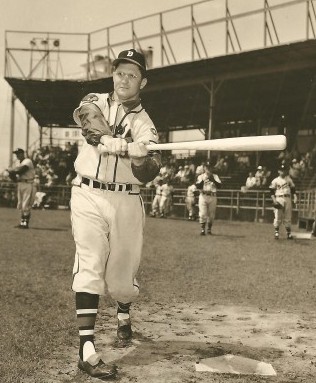
Then all of a sudden, Southworth started platooning. I couldnt believe hed bench me just to have a right-handed batter against a lefty. I was hitting way over .300 against lefties. But I couldnt convince Southworth. I came very close to jumping the ball club at that point. It was the most bitter disappointment of my entire baseball life.
When Torgy retired from baseball, after having a front-row seat for the great 1961 home run duel between Roger Maris and Mickey Mantle, he and wife Norma split up and Torgy married Molly Power, who hailed from White Bear Lake, MN.
Torgy worked for a brief time as a stockbroker with Mitchell Hutchins in Chicago, then operated a sports camp for boys in Westfield, WI. He returned to Everett in 1965, and took a job as parks director for Snohomish County. When the Seattle Pilots arrived in 1969, they hired Torgy to manage their affiliate, the Newark (NJ.) Co-Pilots in the New York Penn League, and then the Clinton Pilots in the Midwest League in 1970.
Snohomish voters elected Torgy a county commissioner in 1972, a position he held for four years. He twice tried for re-election, but his political career never recovered from a felony charge of defrauding the county for labor and materials on his car and summer home, even though he was proved innocent.
After the commissioners job ended, Torgy worked for a timber company and eventually became the Snohomish County Director of Emergency Management, a position he held for eight years.
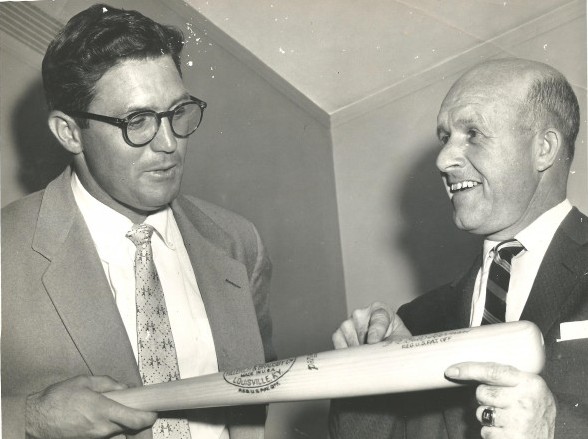
In the fall of 1990, doctors diagnosed Torgy with leukemia. He tried chemotherapy, but it didnt help. Six weeks later, Nov. 8, 1990, he died at his Everett home.
Following a memorial service at Trinity Episcopal Church in Everett, attended by more than 300, and his internment at Grand Army of the Republic Cemetery in Snohomish, County Executive Willis Tucker said, If you had Earl Torgeson for a friend, it was 100 percent, it was unqualified and it was forever.
He would never flaunt the fact he was a big leaguer,” added Charlie Poier, a long-time friend. He would never talk about it unless you’d ask questions. Then he’d go on forever.”
Two months before his death, the main athletic field at Snohomish High School was named in Torgys honor. A citation recognizing the christening said, in part, Your fans and the citizens of Snohomish will always remember the values, integrity and courage modeled by you for their children.
In one of his last interviews, a writer asked Torgy about his reputation as a brawler. He said, with what seemed to be some wistfulness, I regret some of the things I did, and I dont like the reputation I had as a bad guy. I really wasnt a bad guy. I just wanted to win.
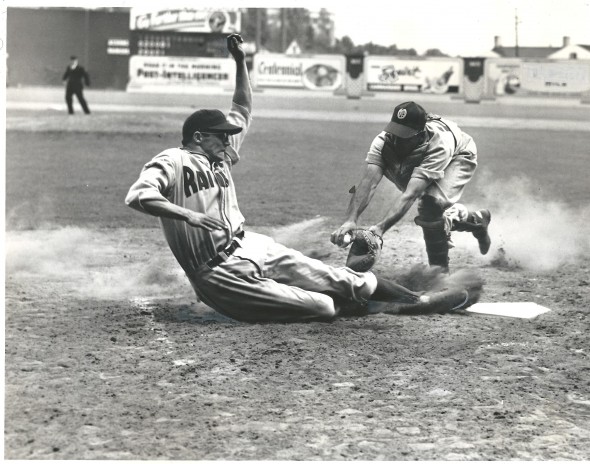
———————————————-
Many of the historic images published on Sportspress Northwest are provided by resident Northwest sports history aficionado David Eskenazi. Check out Davids Wayback Machine Archive. David can be reached at (206) 441-1900, or at seattlesportshistory@gmail.com

6 Comments
Thank you, David, for another marvelous story. I was among the thousands of Puget Sound-area kids who tuned in nightly to Leo Lassen’s Rainier broadcasts and followed Earl Torgeson’s career
with the Rainiers and beyond. As a Bellingham kid, I frequently saw Torgeson play in exhibition games there and saw his brief stint as a pro basketball player with the Bellingham Fircrests.
Incidentally, you mention his basketball teammates Gale Bishop and Al Akins. Both also played for the Bellingham Bells semi-pro baseball team which regularly won the state title and went on to the national tournament in Wichita, Kansas.
You relate Torgeson’s battle with Cliff Chambers in MLB. Chambers was a Bellingham H.S. and Bellingham Bells alum who had competed frequently against Torgeson from
their teenage years onward. Chambers was a real fireballer of his day (he threw a no-hitter for the Pirates) and no doubt had brushed back Torgeson on previous occasions.
During my college years at the UW (1951-5) I served as public address announcer at Bellingham Bells games during the summer months at home. I can recall seeing Earl Torgeson there many times and, on one occasion, saw the First Earl of Snohomish, Earl Averill, play in an oldtimers
game in the early 1950s preceding the regular Bells game. He had been long retired from
MLB. I recall his driving the first pitch he saw some 400 feet into right-centerfield at Battersby
Field and pulling winded into third base with a triple. Great players. Great baseball days. Great memories.
I was a kid in Chicago during the late fifties and followed the go go White Sox in ’59. Torgy was a favorite. Thanks for the great article.
On behalf of David Eskenazi, thank you for visiting and reading,
Thank you, David, for another marvelous story. I was among the thousands of Puget Sound-area kids who tuned in nightly to Leo Lassen’s Rainier broadcasts and followed Earl Torgeson’s career
with the Rainiers and beyond. As a Bellingham kid, I frequently saw Torgeson play in exhibition games there and saw his brief stint as a pro basketball player with the Bellingham Fircrests.
Incidentally, you mention his basketball teammates Gale Bishop and Al Akins. Both also played for the Bellingham Bells semi-pro baseball team which regularly won the state title and went on to the national tournament in Wichita, Kansas.
You relate Torgeson’s battle with Cliff Chambers in MLB. Chambers was a Bellingham H.S. and Bellingham Bells alum who had competed frequently against Torgeson from
their teenage years onward. Chambers was a real fireballer of his day (he threw a no-hitter for the Pirates) and no doubt had brushed back Torgeson on previous occasions.
During my college years at the UW (1951-5) I served as public address announcer at Bellingham Bells games during the summer months at home. I can recall seeing Earl Torgeson there many times and, on one occasion, saw the First Earl of Snohomish, Earl Averill, play in an oldtimers
game in the early 1950s preceding the regular Bells game. He had been long retired from
MLB. I recall his driving the first pitch he saw some 400 feet into right-centerfield at Battersby
Field and pulling winded into third base with a triple. Great players. Great baseball days. Great memories.
I was a kid in Chicago during the late fifties and followed the go go White Sox in ’59. Torgy was a favorite. Thanks for the great article.
On behalf of David Eskenazi, thank you for visiting and reading,